The post Discovering The Real Morocco In The Souk appeared first on The Expeditioner Travel Site.
]]>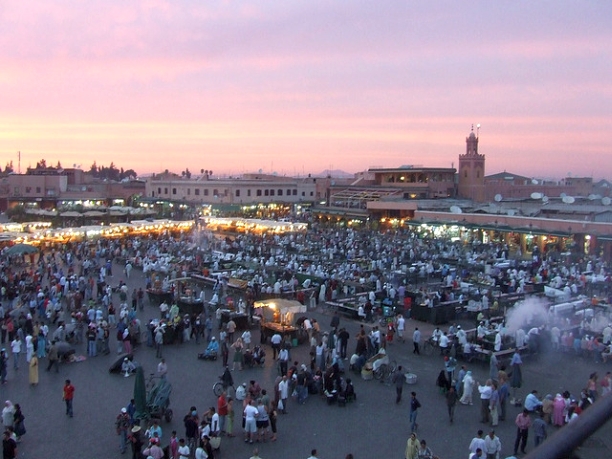
The chaotic atmosphere of Marrakesh, Morocco, is like nothing you’re used to. The coolest city in Morocco is unique in its regimented disorder. Horses pulling green carriages mark the roads that the motorcycles and taxis weave through in a wave of terrifying harmony. The main openings that lead into the narrow souks are at the top of Jemaa el-Fna, Africa’s biggest city square. Before exploring the traditional street markets you must first, however, cross the square, which in the daytime is littered with monkeys on chains, snake charmers and circles of people surrounding physically impaired humans.
I met Mamo working at his stall one Friday night after the food market had quickly sprung up in the center of Jemaa el-Fna and the orange juice vendors had turned on their lights. “You like that scarf? Cheaper than Tesco man,” he said, with a huge smile illuminating his slight face.
“All I have is 30 Dirhams,” I said, offering the equivalent of about $3.50 for the green scarf hanging on the entranceway to Mamo’s cavernous stall.
“What?” he laughed, smoothing the front of his jacket with both hands. “Why you try to pay sheep’s price for a camel? Haha. Come in, come in. No obligation to buy. Come on,” he waved. “What do you want? The scarf is 200 Dirhams. Please, look around.”
And with that he was back outside in the busy walkway outside his stall, opposite the popular Café de France.
Two dark-haired women walked past. “Sarkozy-le maintenant,” Mamo called out jokingly, incorrectly calling for the former French president to step down. The women, both wearing black leather jackets and dark jeans, looked puzzled. “Cosa?” the taller of the two asked.
Mamo’s ears pricked as he searched for the Italian part of his brain. “Ahh, Berlusconi, haha. Le donne italiane sono forti,” Mamo said, tensing his biceps and twinkling his eyes. “Venire. Venire.” His broad smile led the Italians into his territory. They left with a new “genuine fake” Louis Vuitton handbag just five minutes later.
“What did you say to them?” I asked.
“I told them that Italian women are strong women, haha. And, of course, I am right because they decided to buy something for a real price. But not you, London man.”
Mamo, or Mohammed Bouchtat, 19, was born in Marrakesh in 1992 during a particularly cold January. He was also born during a leap year. Apart from those two anomalies, though, Mamo has lived the typical life of a young man in Marrakesh.
I asked him how he learned so many languages, five in all, before the end of his teenage years. Animated with the gesticulation of an Italian, concise in his speech like an Englishman, and as sincere as a Scandinavian, Mamo told me his very Moroccan story.
“You don’t understand,” he said. “ Language . . . ” he paused, looking around at the football shirts and popular brands adorning the tarpaulin walls. “Communication is not learned. For me it is an obligation of Marrakesh. Since I have been eight years I have been here in Jemaa el-Fna. This big,” he said, measuring the height with the universal flat palm at his waist. “You hear the people speak and you learn about them and you want to please them.”
“And your parents?” I asked.
“Here, with me. The right life is to come here where the foreign money is. This is not a special idea, but clever like Alan Sugar, hey?” He laughed.
*
Where the foreign money is, though, happens to be in the pockets of foreigners that can grow tired of the constant Moroccan sales patter.
Jacob Kuhn, a Swedish traveler I met at a rented apartment in the southern town of Essaouira, said he had left Marrakesh because of the vocal salesman like Mamo.
“I hate the desperation tactics they use in the souks and all over the square in Marrakesh,” he said. “Even the taxi drivers wouldn’t leave me alone. The problem for me is that, if I want something, I will get it. And I don’t want people to keep asking me when I’m just walking around, trying to enjoy the city because Marrakesh is also very beautiful.”
The thing is that many visitors are persuaded to purchase items by a group of salesmen that are, undoubtedly, some of the finest communicators in the world. And, when night falls, a new troop enters stage left.
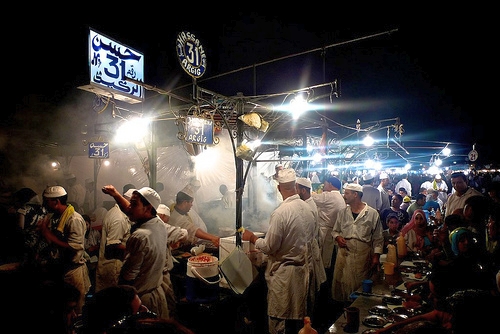
At about six o’clock the African sun breaks into hues of orange and pink upon the Marrakesh skyline, setting beneath the Koutoubia Mosque Minaret Tower that dominates the city’s skyline.
An hour before, the boys from the food market arrive to set up the white centerpiece that houses more than 20 restaurants. Most of the stalls serve similar menus of seafood, kebabs and traditional Moroccan tagines. The main differences between them are the boys that are charged with attracting customers.
Like the boys in the souk, these young salesmen are adept linguists and expert communicators. Within the imaginary border lines that separate each stall, around 6 or 7 of them, ranging from 17 to 30 years old, carefully identify and approach customers from 6 p.m. to 12 p.m. every night of the week.
Having been identified and approached, I sat with my free mint tea and chatted with Hassan, a 24-year-old with long eyelashes and a military-like haircut. Outside the show had begun. One of the boys had spotted a group of English teenagers that, I learned later, were working in a volunteer program helping orphans in the city. The boy looked over to Hassan, the best English speaker, who left with a smile and danced his way onto the stage.
“Wowww, you girls are finger lickin’ good,” he said with a comic glint in his eye. “Hahaha. C’mon boys, ‘no money no honey.’” Around the back of the group two other boys gently encouraged the group closer to the stall’s entrance. With the herd now close enough, Hassan turned to me and began to clap and sing. “That’s the way uh huh uh huh, I like it. That’s the way uh huh uh huh, I like it.”
The chefs behind the huge display of food clapped and sang along. Everyone in the small tent looked over at the group of young English travelers. Hassan’s arm was around the waist of the biggest male in the pack and, after a few minutes of a much practiced comedy routine, including a couple of “high five, too slow,” seven more people were eating food they didn’t know they wanted.
It seems incredible that such a basic shepherding process works so well but, after seeing it on a number of occasions, and talking with both predator and prey, it became clear that much more than just physical herding is in practice.
I failed to get Candy’s last name, but the 20-year-old American from south Florida explained why she ate in the middle of Jamaa el-Fna almost every night, despite the fact that there were so many beautiful rooftop restaurants less that 100 yards away.
“When we first arrived in Marrakesh, I just walked straight past the middle restaurants because they hassled us so much,” she said, twirling a lock of brown hair between her bubblegum pink nails. “Then one night I was on my own and I talked to one of the boys and there was just something about his eyes that was so, I don’t know. Not desperate, like, more determined and confident but really nice as well. And he just said ‘let’s sit down and eat.’ So I did for some reason.”
About Candy, Hassan said “everyone needs something different.”
Candy was lured to the same stall as me and, although Hassan sat with her that one time, I have never seen him do it again. Does she care?
“No because I get free tea and sometimes I don’t buy anything, I just sit here and listen to the drums and watch people walking around. Plus the food is actually really good.”
What she is also doing, apart from enjoying the unquestionable enchantment of this city in the evenings and the excellent calamari, is making the stall look popular and helping to bring in more business.
Most guide books, including Lonely Planet, advise travelers to eat at the busiest stalls. What most guide books don’t tell their readers is that Jemaa el-Fna, with all of its disorder, is a finely tuned sales floor where the patrons have covertly domesticated what looks an untameable bull.

Back at his stall, Mamo continued with his sale. “Listen, don’t tell anybody, but . . . ” I waited in anticipation as Mamo waved to the Italian girls who must have been doing another lap.
“You can buy this scarf for 50 Dirhams,” he said, without an ounce of insincerity. The tiny scarf was in a holey Tesco bag and in my hand before I said a word back. I handed over the green 50 Dirham note over and shook the salesman’s hand.
On my way out I noticed the ragged shoes on Mamo’s feet. “Was our whole conversation just about the scarf?” I asked.
“You don’t like the scarf?” he asked back.
When I returned the next day another boy on the stall told me Mamo had gone to look after his mother and wouldn’t be back until the next day. He wasn’t there the next day either.
“No,” I thought, walking through Jemaa el-Fna as dusk fell that Monday, “Our conversation was about survival.” And I didn’t understand a word of it.
By Ryan Child
[Jemaa El Fna by Britrob/Flickr; Jemaa el Fna Food by Alessandro Benedetti/Flickr; Remaining photo by the author]

ABOUT THE AUTHOR
 Ryan Child is a freelance journalist and writer from the little town of Frome, England. He went to university in the United States before getting lost in Morocco. Ryan now works as a content writer for Argus Car Hire and a researcher for Insight Publishing in Bristol, England. You can find more of his work at WaywardPolitics.wordpress.com and PriorityBoarder.com. Or follow him on twitter at @rochild89.
Ryan Child is a freelance journalist and writer from the little town of Frome, England. He went to university in the United States before getting lost in Morocco. Ryan now works as a content writer for Argus Car Hire and a researcher for Insight Publishing in Bristol, England. You can find more of his work at WaywardPolitics.wordpress.com and PriorityBoarder.com. Or follow him on twitter at @rochild89.
The post Discovering The Real Morocco In The Souk appeared first on The Expeditioner Travel Site.
]]>The post Top 5 Coastal Towns In Morocco appeared first on The Expeditioner Travel Site.
]]>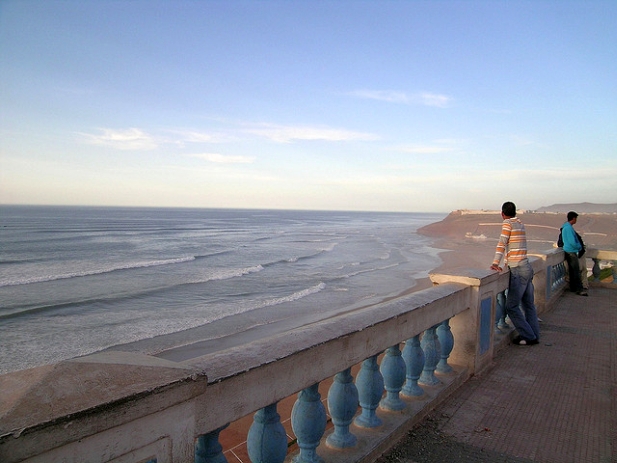
Spain still has the monopoly on coastlines blighted by ruinous tourism development, but Morocco, just a ferry-ride away, is still largely untouched.
Aside from Agadir and its package holiday resorts, Morocco’s coastline harbors many intriguing settlements. Some of these have long been on the independent traveler’s radar, but some have hardly been explored at all.
Given the country’s diverse interior geography, it should come as no surprise to find out that its almost 1,200 miles of coastline exhibits a similar diversity.
So what are you waiting for? Dive in and choose the spot that suits you best.
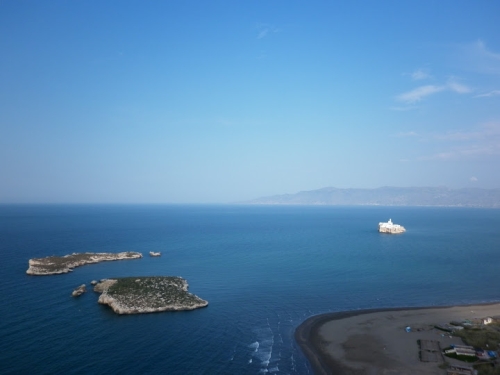
1) Al Hoceima
This Berber port town has it all: isolated beaches, nearby hiking in the Rif Mountains and a remarkably friendly population. Due to its location on the east side of a small promontory, it enjoys glorious sunrises over its shimmering share of the Alboran Sea, a part of the Mediterranean.
Developed by the Spanish during the colonial era of the early to mid-20th century, the town hugs its coastline tightly, overlooking a precipitous drop to its port and town beach. Its center is an organized grid of inspired colonial architecture, which will keep you occupied for an evening, but it’s the captivating natural beauty of the surrounding area which will provide the most interest.
Of the numerous nearby beaches, the Plage Asfiha stands out. Easily reached by taxi, this stretch of golden sand is technically about 160 feet from Spain. Morocco’s northern neighbor claims three small islands here, a relic of its colonial ambitions and a much disputed geopolitical issue. Enjoy an afternoon here before walking back through the hills for some spectacular views.
The town is now easily reachable by a recently constructed coastal highway running east from the popular tourist towns of Tetouan and Chefchaouen. Alternatively, you can try the ferry route from Almería in Spain.
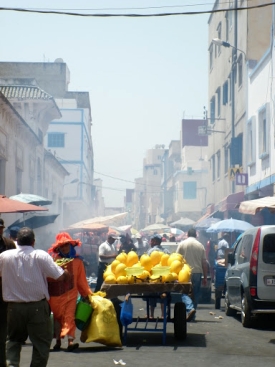
2) Larache
A truly unfrequented destination, Larache was the main port for the Spanish in northern Morocco. Like Al Hoceima, it boasts characteristic colonial architecture, though with more of a variety of styles. From Portuguese forts to the unique look of the municipal souk, these attractive constructions are largely centered on the main roundabout that links the old town, the coast and the modern town.
Apart from being able to lose yourself in a genuine Moroccan medina without the accompanying hassle from tourist touts, Larache possesses a stretch of wild Atlantic coast across the river Loukkos. Getting there is as much fun as the beach itself. On sunny days, the competition with families to get a space on the many overcrowded dinghies that ply the route can be fierce.
A bus ride away lie the humble ruins of Lixus, a Roman settlement with a small amphitheater and proof that this region of Morocco was once popular with visiting Europeans.
In typically Spanish style, Larache’s inhabitants congregate en masse in the city’s streets for the paseo, or evening stroll, making the town an agreeable and pleasant place to spend a few days.
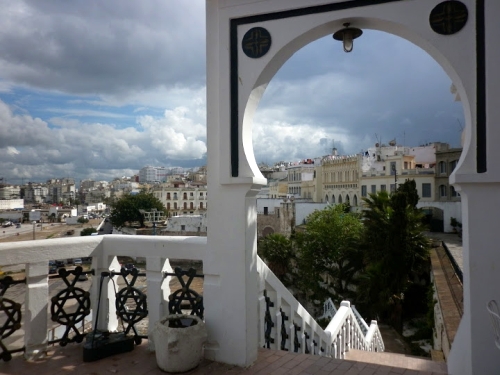
3) Tangier
It may not be relaxing, it may not even be pretty, but Tangier is a must-see for any visitor to Morocco. An utterly convoluted recent history places this coastal enigma in a league of its own, and offers the discerning traveler an opportunity to delve deep into a past forever tied to the sea.
Its location on the Strait of Gibraltar and the meeting point of ocean and sea give Tangier its importance. The inspiration for Casablanca, Tangier was subject to a complex experiment in international cooperation, which led to the city acquiring an unscrupulous reputation.
Crumbling mansions and theaters, villas and consulates all played host to these intrigues, and now offer the visitor an enchanting maze of streets to explore.
Of course its inhabitants were profoundly affected by this international attention, but one lasting legacy is the unhurried cosmopolitanism of the city. Locals will greet you in a surprising range of languages.
Though thoroughly neglected following independence in 1956, Tangier has recently become the focus of significant investment, both foreign and domestic. This has led to a broad development of its infrastructure, and the making of a memorable destination from which to contemplate the sea.
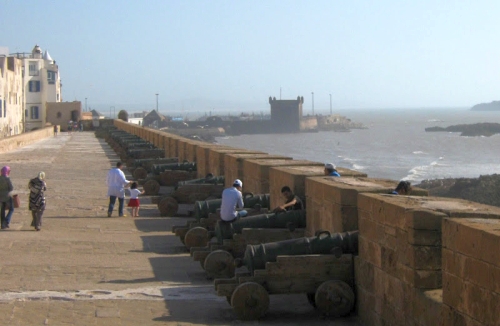
4) Essaouira
By now a well-known destination for visitors to Morocco, Essaouira is a fortified fishing town due west of Marrakech. Its proximity to that metropolis makes it the most accessible destination on this list.
Battered and eroded by Atlantic swells for centuries, the town has a worn but defiant appearance. As an example of impeccable naval defensive design it is unparalleled, but its attraction extend far beyond such impersonal details. An active artistic community, expatriate and local lends an genuinely creative spirit to the narrow lanes and alleys of the medina. With abundant galleries and art shops to stumble across, Essaouira is inspiring yet undemanding.
To fill your day you could ride south along the beach, around the bay to the mouth of the Oued Ksob to enjoy the simple power of the ocean with Mogador Island in plain view.
In the evening, as the wind blusters overhead and the unassuming fish stalls near the port prepare their delicious snacks, you will quickly understand the town’s enduring appeal.
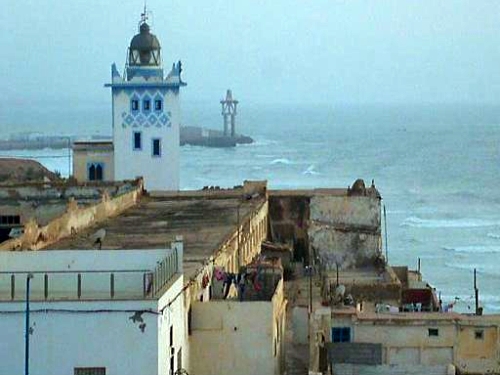
5) Sidi Ifni
Surely one of the most singular and curious little towns on the planet, Sidi Ifni is an eternally laid-back remnant of Spanish colonialism situated on the violent Atlantic coast of southern Morocco. Almost entirely constructed during a 30-year period in the early 20th century, it features a number of exceptionally interesting buildings, from a former naval academy in the shape of a ship to a central square with some distinctive Art Deco design. Ifni’s curiously empty streets have the feel of a town lost.
With time, however, you’ll find a population of affable fishermen and Berber musicians, a couple of great restaurants (Cafe Nomad and the Suerte Loca Hotel), and even some comfortable bars. Days can be spent hiking the hills that surround the town, lazing on the town’s spotless beach or even taking a stroll around the ruins of a zoo once built for the families of Spanish soldiers stationed in the zone.
Nearby excursions include the obscure mausoleum of Sidi Ouarsik and a rusting cargo vessel shipwrecked on the beach. For the more active traveler, the renowned beach of Mirleft and its accompanying surfing community are well within reach.
If you visit during the summer, a haunting Atlantic mist will be one of your abiding memories. Visit in winter, however, and you may be surprised to see dozens of French retirees with their camper vans on the beach. Ifni has long been a quiet destination for independent travelers in the know, but it’s still a relatively well-kept secret. Experience it while you can.
By Aidan McMahon
[Vue de Sidi Ifni by Hugues/Flickr; Remaining photos via the author]

About the Author
 Aidan McMahon is an aspiring filmmaker and likes languages, history and cheap hotels. Browse his city itineraries at UnAnchor.com.
Aidan McMahon is an aspiring filmmaker and likes languages, history and cheap hotels. Browse his city itineraries at UnAnchor.com.
The post Top 5 Coastal Towns In Morocco appeared first on The Expeditioner Travel Site.
]]>The post Space, Time And Fez appeared first on The Expeditioner Travel Site.
]]>
He shrugged at me.
“It’s Berber silver, sir.”
“It isn’t though is it? Because it isn’t Berber, and it isn’t silver. Therefore, not Berber silver. Anyway, you didn’t mention the Berber bit when you sold it to me. I think the word you used at the time was ‘Sterling.’ I want my 200 dirham back.”
He smiled sweetly.
“Look, you lied to us and I want my money back. You can deal with me now or you can deal with me when I come back with the police. Up to you.”
I wasn’t sure if anything I’d said had had the slightest effect until I said the word police. He wasn’t smiling anymore.
“Sir, there is no problem, no problem . . .”
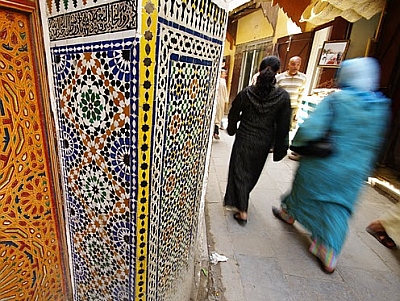 Walking back to our riad with the recovered dirham, we felt as triumphant as we had downcast the first time he fooled us. Dammit, we had been so careful not to get caught up in anything like this and in fact had had a very positive experience so far in the souks here in Fez, Morocco — very little of the hassle and pushiness we had been warned about so effusively by people who had never been here had materialized. Some polite enquiry, a bit of banter — nothing more. But there’s always one, isn’t there?
Walking back to our riad with the recovered dirham, we felt as triumphant as we had downcast the first time he fooled us. Dammit, we had been so careful not to get caught up in anything like this and in fact had had a very positive experience so far in the souks here in Fez, Morocco — very little of the hassle and pushiness we had been warned about so effusively by people who had never been here had materialized. Some polite enquiry, a bit of banter — nothing more. But there’s always one, isn’t there?
We had lists. My fiancée, K, wanted a leather bag, sandals, the aforementioned silver bracelet. I was after an antique print of the city if I could find one, a pair of Ray-Bans (questionable origin) and one of the little round, flat-topped hats that come from here and share the city’s name: Fez.
Not surprising, I suppose, to find a bad egg in amongst the crush of vendors that line this sloped, serpentine alley. Each shop is barely a hole in the wall — two meters wide if that — and the street is long; it leads all the way from Bab Boujloud, one of the old city gates, to the heart of the medina.
And in Fez, that’s a long way. The medina here is the largest intact medieval city in the Muslim world; home to over 200,000 inhabitants and around 9,400 streets, not a single one of them wide enough for four wheels. We find ourselves frequently hugging the walls to make way for charging beasts of burden or men with carts, or taking shelter in one of the shops and negotiating the verbal skills of yet another vendor, hard cases who sell their wares about two inches from your face — redefining your sense of personal space even as they overcharge you for the little mother-of-pearl inlaid box you never knew you wanted.
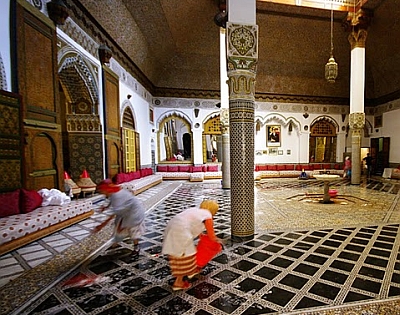 The tight squeeze, the sales pitches, the thousand and one smells and sounds, they all make the return to our tranquil courtyard a welcome one. Riads are usually restorations of typical bourgeois Islamic homes and follow a standard pattern. Very few — if any — windows face out onto the street. The Muslim home is instead turned inward and is built around a patio, usually with a water feature of some kind. Sunlight makes its way into the home through this inner sanctum — from above. Bedrooms and salons surround the patio on a number of levels.
The tight squeeze, the sales pitches, the thousand and one smells and sounds, they all make the return to our tranquil courtyard a welcome one. Riads are usually restorations of typical bourgeois Islamic homes and follow a standard pattern. Very few — if any — windows face out onto the street. The Muslim home is instead turned inward and is built around a patio, usually with a water feature of some kind. Sunlight makes its way into the home through this inner sanctum — from above. Bedrooms and salons surround the patio on a number of levels.
It’s the opposite in both feel and dimension of the streets outside, and in fact goes a long way to explaining those narrow lanes: space was prized here and hoarded in the home rather than squandered in squares, public parks or wide streets.
The visitor to Fez is at a disadvantage. Where the Muslim resident can escape for prayer, when we ventured out again we were restricted to the dizzying and at times panic-inducing crush of the souks. The city is home to several mosques — the Qaraouiyine Mosque, the Jamaa Andalous — that are major in terms of both importance and scale but you wouldn’t necessarily know it even if you were standing right outside; in this warren of alleys looking up reveals little more than a blue crack of sky. The presence of the mosques is betrayed only by peeking through the doors at the airy courtyards and ablution fountains — sky, billowing breezes, flowing water, space. A sacred and reserved place; this is as far as the non-muslim can go.
Though, we weren’t entirely without options when it came to escaping the mayhem. Attached to any self-respecting Mosque you’ll find a madrasa, or medersa as they are called here (an Islamic school). They tend to be tranquil spaces, and in Fez there are a number of historical and spectacularly beautiful examples. Best of all — the non-muslim may enter.
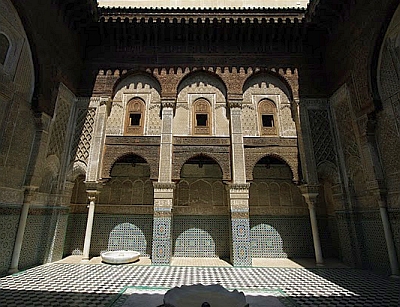 The Medersa Attarine was built between 1323 and 1325 and is a treasure of Andalusian-Moroccan art. If you have been to the Alhambra in Spain you will know what I’m talking about. Seeing this place has the effect of expanding one’s sense of Andalusian space. There is a little of medieval Spain here just as there is a lot of medieval Morocco in Spain. The place has a calming and uplifting effect and we lingered before heading to the Andalusian Quarter — the most ancient part of the medina — founded by refugees from the Reconquista in Spain.
The Medersa Attarine was built between 1323 and 1325 and is a treasure of Andalusian-Moroccan art. If you have been to the Alhambra in Spain you will know what I’m talking about. Seeing this place has the effect of expanding one’s sense of Andalusian space. There is a little of medieval Spain here just as there is a lot of medieval Morocco in Spain. The place has a calming and uplifting effect and we lingered before heading to the Andalusian Quarter — the most ancient part of the medina — founded by refugees from the Reconquista in Spain.
We made our way there using one of a number of colored walks — the blue one — that the city authorities have provided for the visitor. They aren’t always that easy to follow and getting lost in the medina is always just a corner away even with them, but they make a nonsense of the claim you will often hear that a guide is necessary to explore Fez.
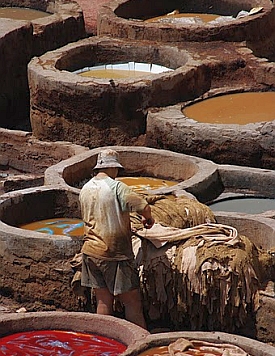 The walk took us past the Chouara tannery, a 14th-century construction of pools and basins used to dye camel, goat, sheep and cattle hide with indigo (blue), poppies (red), saffron (yellow) and henna amongst other materials. One of the largest open spaces in the city and an impressively timeless sight — it stinks to high heaven. We could observe the tannery workers from a terrace to which we were guided for a small tip; sprigs of mint thoughtfully provided to take the edge of the smell.
The walk took us past the Chouara tannery, a 14th-century construction of pools and basins used to dye camel, goat, sheep and cattle hide with indigo (blue), poppies (red), saffron (yellow) and henna amongst other materials. One of the largest open spaces in the city and an impressively timeless sight — it stinks to high heaven. We could observe the tannery workers from a terrace to which we were guided for a small tip; sprigs of mint thoughtfully provided to take the edge of the smell.
Across the river in the Andalusian Quarter we lost our way — several times, and not in a fun way. The day was a hot one and the souks here shabbier, the streets dirtier, the fake guides more insistent. When we finally found what we were here for — the Medersa Sahrij — we weren’t exactly thrilled to find it closed for restoration . . . for the next five years.
The mood switched when it became obvious that the attendant would be amenable to a little bribery. Payment made, he unlocked the massive wooden doors for us and warned that we will have to be quick. We stepped in and down into the sunken entrance; he unlocked an inner door of mashribiya (wooden lattice) and retreated.
This place had been high on my list and I had never expected that we would have it to ourselves. The medersa is named for the pool that takes up most of the courtyard and that was empty. A puddle at the bottom and a few weeds grew in and around it, sprouting up between deteriorated tiles. The whole place was unkempt and in disrepair and was without a doubt the most beautiful space I’d seen so far in Fez.
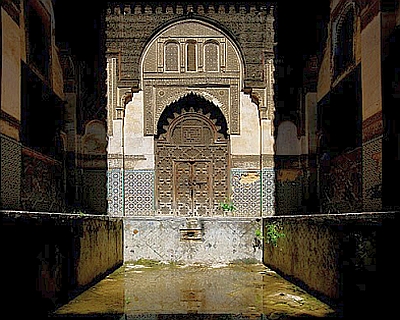 There was something about being there alone, on a clandestine visit and seeing the art and architecture in this state — pre-restoration — that made it a glimpse of something hidden. We felt much closer here to the people who had built it than we did in restored sites elsewhere. The distance between us and them was mapped out in the crumbling plasterwork and the sun-baked mashrabiya. I was looking at the original work and could touch with my hand what a 14th-century artisan had made with his.
There was something about being there alone, on a clandestine visit and seeing the art and architecture in this state — pre-restoration — that made it a glimpse of something hidden. We felt much closer here to the people who had built it than we did in restored sites elsewhere. The distance between us and them was mapped out in the crumbling plasterwork and the sun-baked mashrabiya. I was looking at the original work and could touch with my hand what a 14th-century artisan had made with his.
Back to the alleys. We followed another walk, or tried to. The green one, which is all about palaces and gardens apparently — but not for us. For us, it was about hunger. It didn’t seem to be particularly big on restaurants or cafes, that part of town, until we spotted a hole in the wall adjacent to one of the palaces highlighted in our guide.
There was nothing to distinguish the hole (a hatch in the wall, a few steps down, a bearded man frying an egg over a solitary hotplate) from someone’s kitchen except for a baffling sign overhead that announced tea and panoramic views from the terrace. We concluded that it must have been referring to the palace and I gestured to the man to ask him. He indicated that we should descend the few steps into the sunken opening. Like the gentleman I am I asked K to precede me.
“No, you first”
We were led through a narrow and bafflingly disused galley kitchen behind the hatch’s hotplate, up a slender flight of stairs at the back and into what appeared to be a small family living room, if a little over populated with tables. There were sliding doors at the rear and the view was indeed panoramic — over the medina with its minarets and the more distant hills crested by Merenid Tombs. It was the widest vista we had been presented with, the most enormous open area.
Storks and larger birds of prey hovered over the city as we surveyed the walls and the koranic script and photos of Mecca that hovered over us. This was not what it had looked like from out front. Neither was it our only elevated dining experience in Fez; just the previous evening we had eaten on one of the city’s many roof terraces, just beneath an ornate blue-green minaret, watching the pair of kestrels that nested in one of its cavities.
We were served up a simple potato omelette — the single item on offer — and when we went to leave, down the small stairs and through the tiny kitchen, we were prevented from doing so by the proprietor who was blocking the exit with his prayer mat. When he finished he stood, thanked us for waiting and accepted an improbably small amount of money for the meal.
We squeezed out though the hatch, back into the crush and rush of the claustrophobic souks, the wide open spaces of our discovery.
By Robin Graham

ABOUT THE AUTHOR
 Robin Graham has written for In Madrid, The Expeditioner and the Matador Network. He regularly contributes to The Spain Scoop and blogs at the award-winning Alotofwind. Follow him on Twitter: @robinjgraham.
Robin Graham has written for In Madrid, The Expeditioner and the Matador Network. He regularly contributes to The Spain Scoop and blogs at the award-winning Alotofwind. Follow him on Twitter: @robinjgraham.
The post Space, Time And Fez appeared first on The Expeditioner Travel Site.
]]>The post Lonely Planet’s Top 10 Countries For 2010: And The Winner Is . . . appeared first on The Expeditioner Travel Site.
]]>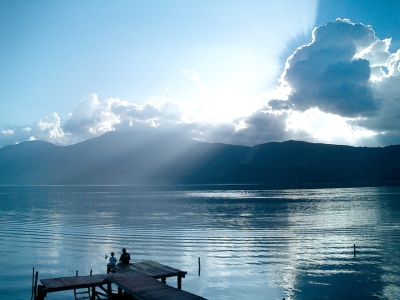
Lonely Planet’s doling out accolades to these ten countries as being very topping, with El Salvador being the toppingist of them all. Okay, they don’t really elaborate as to what this list mean, other than being the “hottest countries for next year,” but I assume they mean destinations that are, or have been, under the radar and are just coming into their own as hot spots for travelers. Which usually means one thing: Get there now before they’re firmly on the tourist trail.
Rounding out the top five are Germany, Greece, Malaysia and Morocco. And at number 10, experiencing a little Obama bounce, the U.S.A., which given the likelihood of a an anemic dollar for the near-term future, will likely be at the top of the list for many visitors, especially those carrying the enviably strong euro.
So what’s missing here? I may sound like a broken record, but let’s give a shout out to Colombia, a country whose culture and diversity, not to mention accessibility, makes it a great “top” country in 2010. A few of my own honorable mentions: Panama (have you seen how cheap it is to fly there in the winter?), Ireland (see Panama), and Namibia (everyone I met in Africa who was visited the country raved about the outdoor adventures that can be had there).
The post Lonely Planet’s Top 10 Countries For 2010: And The Winner Is . . . appeared first on The Expeditioner Travel Site.
]]>The post Who Knew Morocco Was For Surfers? appeared first on The Expeditioner Travel Site.
]]>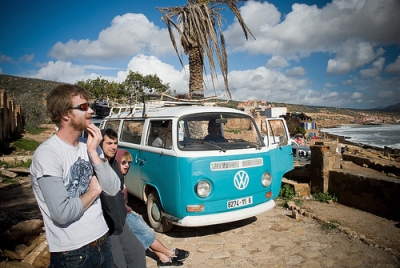
For those looking for a little surfing getaway while in North Africa, look no further than Taghazoute, Morocco, a small fishing village in Southern Morocco that has started to gain a big following in the surfing community. Prime surfing season is September through April when you can expect swells from 3 – 15 feet, or for wusses you can come in the summer and ride the bunny hill-like waves.
Matador has the low-down on where to stay, what to eat, and most importantly, where to catch some waves. (Do surfers actually say “Catch some waves”? I have to admit, most of my surfing knowledge comes from the movie “Point Break.” Surfers rob banks to finance their lifestyle too, right?)
The post Who Knew Morocco Was For Surfers? appeared first on The Expeditioner Travel Site.
]]>The post Rockin’ The Casbah With Richard Bangs appeared first on The Expeditioner Travel Site.
]]>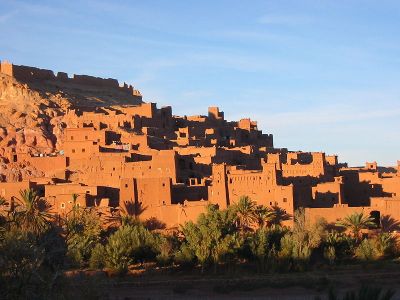
“In desert we have time but no watch. In America you have watch but no time.” The enlightened words of my Berber guide reverberated in the silence of the Sahara. Just a speck on one of the many majestic dunes, I sat there — phone in one pocket, iPod in the other — gazing up at the star-studded sky, contrasting my own fast-paced, self-isolating culture with that of his people’s; one strongly tied to tradition, community and an appreciation for the present moment in time.
The Berber’s words came back to me as I listened to Richard Bangs explain his own exploration of those very same differences while traveling throughout Morocco. Speaking from The Explorer’s Club in New York, Bangs was in town promoting his upcoming PBS documentary, “Morocco: Quest for the Kasbah,” his fourth in a series of eco-friendly jaunts around the world.
Instead of the desert, Bangs’ focus is on the Kasbah — a fortressed community that has remained the epicenter of Moroccan life and culture since before Islam violently swept across Africa. As a safe haven, it has been a place for people to exchange goods as well as ideas, providing the breeding grounds for multiculturalism and tolerance.
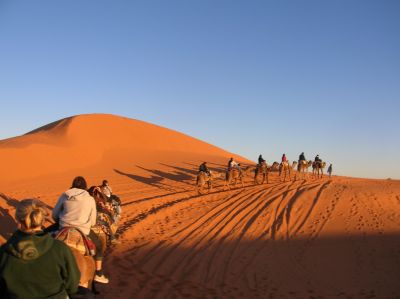
Like my own unforgettable excursion in Morocco, the first half of Bangs’ quest begins in Marrakech where he explores the massive square, Djemaa el Fna, and the city’s eclectic souks. From here he moves west to the coastal city of Essaouira, then crosses the snow-capped High Atlas (or Grand Atlas) mountains to the Sahara where he spends a night beneath the stars in a nomad tent. The second half of his exploration takes him north to the cities of Fès, Tangier, Rabat, and finally to infamous Casablanca where his epic journey comes to an end.
“Morocco has a world view developed through centuries of nomadic movement,” Bangs says wistfully. “It is a berth for people of all backgrounds and faiths to gather and share, a country that celebrates and respects the interconnectedness of the family man. Morocco today, and always, is a Kasbah with an open door.”
The post Rockin’ The Casbah With Richard Bangs appeared first on The Expeditioner Travel Site.
]]>The post Discovering Tangier With A Little Help From A Friend appeared first on The Expeditioner Travel Site.
]]>
Many travelers skip Tangier on their way to the rest of Morocco due to the city’s sordid history and dodgy reputation. But, as I discovered, sometimes all it takes is just a little help from a friend from the inside to discover the wonders of the city.
By Jeffery Smith
“Why don’t we go to Marrakech tomorrow?” somebody casually suggested during a lull in the conversation. It was late into the night, and I had just spent the last several hours sipping wine and sherry with a group of Britons at a ranch located in the verdant hills between Vejer de la Frontera and Barbate in southern Spain. A few minutes later it was decided: Oliver — a friend of mine — and I would hop on a ferry on the southern coast, make our way to the train station in Tangier and take the overnight to Marrakech. We were wary of spending too much time in Tangier because we both had parents with dubious experiences there in the 70’s. But if all went to plan, we’d only have to spend a few hours in the fabled city. As it turns out, a few hours in Tangier wasn’t nearly enough time.
Most travelers familiar with the region would suggest going to Algeciras to catch the ferry to Tangier, but instead we opted for a 45-minute bus trip bound for the wind-swept town of Tarifa, a city we had been to a few weeks prior. Tarifa is the windsurfing capital of the world and ten minutes on the small peninsula reveals why: the levante, or dry, hot wind, is unrelenting. Ten days in Tarifa — for those of you who are not inclined to windsurf — and you will quickly understand why the area has such a high suicide rate. From here we took the Tarifa-Tangier ferry. Run by a monopoly called FRS, the voyage is a short 35-minute jaunt across the Strait of Gibraltar.
Tangier sits at a cultural crossroads. It is home to nearly a million people with a diverse mix of religious and artistic influences. Founded in fifth century B.C., Tangier has been home to the Phoenicians, Romans, Portuguese, French, and Spanish before gaining its full sovereignty. In fact, it wasn’t until 1956 that Tangier officially became part of Morocco.
The gateway to Morocco is also an important entry point for the Mediterranean. Trade and commerce drive the city’s frantic pace. Food vendors and fruit carts line the inner city streets alongside rows of cable and low-hanging electricity lines. The traffic and bustle blends to white noise once you start to appreciate the aged architecture of this ancient city. Moorish towers and crescent moons dot the cityscape, while the cobblestoned streets and whitewashed dwellings reminded me of southern Spain. The main drag along the coast, Avenue Mohammed VI, boasting multistory high-rise hotels, palm trees and modern business buildings reminded me of Rio de Janero. But the strange and beautiful call to prayer adds a quality incomparable to any city outside the Arabic world.
After exiting down the ramp from the ferry, we were met with the daunting task of passing hoards of taxicab drivers, tourist “guides” and those generally looking to find any rube who might give them money. We avoided the first and second stream of hasslers, waving them off with “no thank you,” “no gracias” and “la shokram.” We made our way to the foreign exchange kiosk to trade our Euros for Dirham and it was here that we met Hassan.
Hassan had an extensive English vocabulary and he offered to show us around; he proved to be a blessing in disguise. He was helpful in securing a taxi, train tickets, luggage check, and scheduling our food and souvenirs before meeting the six o’clock departure. Our taxi took us to various places, teeming with people and commerce, but with Hassan, we were never idle for too long before moving on to a new corner of the city.
After a little while spent seeing the city, Hassan took us to see what he described as “a traditional Berber with the finest rugs in all of Morocco.”
“Friends,” Hassan said as our car weaved in and out of traffic though the city’s narrow streets. “I know where we can get the best quality rugs and jewelry in all of Tangier.”
“We’d kind of just like to just grab a small meal and go to the train station,” I told him, mindful of the time.
“No, no.” Hassan protested, dismissing my suggestion with a wave of his hand. “You need to meet my friend. He is a real Berber and is only in town for another week. He travels from the desert with his people’s rugs and crafts.”
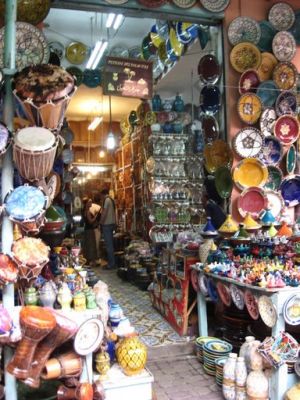 “We’ll just get those things when we go to Marrakech,” Oliver replied.
“We’ll just get those things when we go to Marrakech,” Oliver replied.
“No, no. Marrakech will not have these authentic Berber rugs. Trust me.”
Five minutes later our driver jammed the gear-shift into park and we were soon following Hassan up a set of stairs, walled on either side by a hidden corridor of workshops, stores, tea bars and fruit carts.
Hassan’s friend, Cherif Khalifi Mustapha, was not your typical-looking Moroccan Berber — at least not according to how I envisioned it. He was around 45 years old, had fair skin, towered over most Moroccans at five-foot-eleven, weighed around 200 pounds, and he wore a traditional hooded garment called a djellaba.
Mustapha was educated and raised in Spain, but after leaving to travel Africa, he decided to adopt the Berber lifestyle and philosophy of simplicity. Living in small tents and focusing on religious meditation, Mustapha was part of a group called “Les Nomades” and he traveled from the desert to Tangier regularly to sell his people’s rugs, jewelry and other handicrafts. Mustapha was an expert salesman who obviously had experience with the Westerner mindset. He was cordial and informative, offering us several rounds of traditional mint tea. After explaining “Les Nomades,” he began dressing us as blue and azure versions of himself — having us try on native turbans and djellabas. Then he began taking out rugs and jewelry insisting that price was not important — “Only focus on what speaks to you,” he would say.
The rugs ranged in size, complexity and fabric, but they were all stunning. So too was the price of his people’s handiwork. Ranging from a few hundred dirham to a few thousand, I found that my haggling skills were not what they needed to be for this situation. Nevertheless, I came away with a fine assortment of Berber crafts that did, as Mustapha had suggested, “speak to me.”
Afterwards, Hassan took us out to eat before loading on the train. We had explained to Hassan that we were looking for something light and cheap — this was not what he delivered. But, after finishing our memorable meal, we had no regrets.
The Moroccan chicken wrapped in pastry and traditional couscous was absolutely divine. The chicken was moist and the dish’s rich spices, tinged in cinnamon, gave my senses a crash course in Moroccan cuisine. Hassan never promised to take us someplace cheap, but he did promise to show us the best food in all of Tangier, and he didn’t let us down.
It turned out, Hassan was not only a blessing in disguise, but a guide in disguise. He gave us a quick education on the Moroccan haggle, showed us more of Tangier in an afternoon than most might see in a week, and made us realize that we had a lot to learn before getting off the train at our next stop in Marrakech. If only every city in the world had their own Hassan.

The post Discovering Tangier With A Little Help From A Friend appeared first on The Expeditioner Travel Site.
]]>The post What Happened To Edgy Tangier? appeared first on The Expeditioner Travel Site.
]]>
Seedy coffeehouses, hashish-smoking partygoers, and a long history of counterculture, Tangier may be cleaning up its act a little due to the efforts of King Mohammed VI, but it doesn’t take long to see the city like Burroughs did back when he holed up here to write Naked Lunch, or how the countless number of spies who were stationed here did when the city was in limbo and without a country.
The post What Happened To Edgy Tangier? appeared first on The Expeditioner Travel Site.
]]>The post How About Trekking 2,500-Meter Mountains In Morocco For X-Mas? appeared first on The Expeditioner Travel Site.
]]>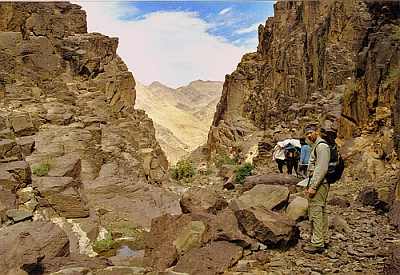
Looking for a calm, relaxing spot to spend your holiday? Then forget the Jebel Sahro mountain range. About a day’s drive from Marrakesh, Morocco, and just on the border of the Sahara Desert, these sparse but magnificent peaks offer some of the best winter hikes in the world for those looking for outdoorsy adventure in relatively close proximity to Europe and North America.
Tours, as described here, through the region can be arranged which offer insight and close-encounters with these mountainous cultures. Now the real question: How are you going to watch “A Charlie Brown Christmas” with no electricity?
The post How About Trekking 2,500-Meter Mountains In Morocco For X-Mas? appeared first on The Expeditioner Travel Site.
]]>